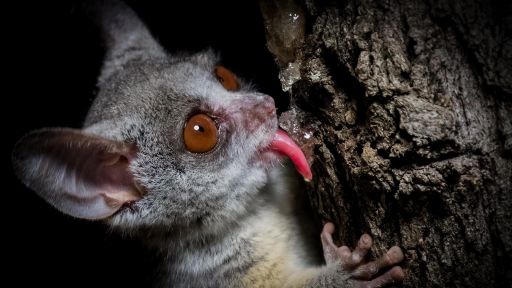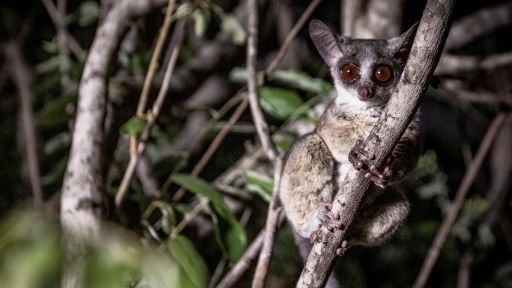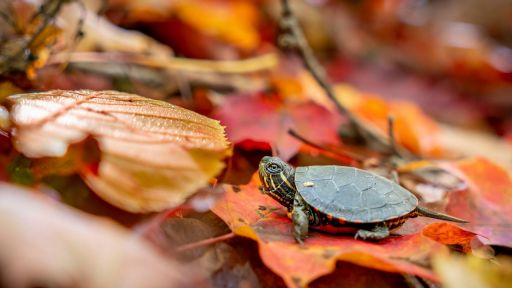The Big Little Journeys team employs a range of filming techniques to follow the journeys of two very different animals. New probe lenses and motion control systems are used to see the world from the perspective of a walnut-sized turtle and follow its journey through a Canadian woodland. In South Africa night vision cameras and gyrostabilized cranes are used to keep pace with a fast-moving nocturnal bushbaby and camera traps reveal how these plucky primates break into a city zoo to steal food. Narrated by Aaron Pierre.
Features



- [Narrator] To film the tiny animals featured in this series, the Big Little Journeys team needed specialist camera technology.
And for the two animals in this episode, very different approaches were needed.
- Painted turtles and bush babies couldn't be more different.
Bush babies are very unpredictable.
They're like ping pong balls pinging from tree to tree.
You think they're gonna land in a certain place and then they land somewhere completely different.
And then the painted turtles are incredibly slow moving.
They only move when they want to move, which is absolutely fair enough.
So they just go whichever way they want.
(turtle rustling) - [Narrator] Arriving in South Africa, the team set about filming the bush baby's journey first.
They are equipped with a five meter long gyro stabilized camera crane.
- It allows us to get into the bush babies world, up into the canopy.
And follow them smoothly as if we're traveling alongside them.
- [Narrator] Such complex moves require two people.
One operates the crane, while the other controls the camera.
- So to be able to control the crane, I've got focus on this hand, and a joystick on this hand.
Thankfully, 15 years of playing computer games are finally paying off.
It's quite a challenge trying to follow them and sort of cross coordinate all the different moves.
But once you get that shot where the bush baby's moving, the camera's following it, you can't beat that.
- [Narrator] In Canada, getting into the painted turtle's world presents the team with the opposite challenge.
And requires a totally different camera set up.
- Probably need to get lower again, but as long as it's level this way.
- We've turned it upside down so that we can actually push forward on the slider.
So this allows us to follow the turtle as she goes through the undergrowth.
- So I can try programming-- - [Narrator] But the team must constantly reset and re-level the rig over and over again in order to capture every stage of a turtle's journey.
(bright music) In South Africa, bush babies are not the only animals the crew need to watch out for.
There have been reports of lions in the area.
- We're in the pitch black, filming, you know, looking up in the trees for our bush babies, and not on the ground for lions.
So it is a little bit stressful.
- [Narrator] But the crew must keep filming, as this is the peak time for bush baby activity.
- Right now, it's super dark.
We can't see anything, so we're using really low light cameras to suck in as much light as possible into this world that the bush babies live in.
- [Narrator] 16 times more sensitive than human vision, the cameras are able to see the world as if through the bush baby's eyes.
(mysterious music) - [Camera Operator] They're just so intriguing and so engaging to watch.
It's such an amazing challenge.
(insects chirping) - [Narrator] But just as the crew are making progress, news comes in that the lions have been spotted only 300 meters away.
(animals calling) - [Amy] Did you hear that?
(animals calling) - We were filming the bush babies, we kept hearing all these alarm calls.
The rangers have said, you know, it's getting a bit dodgy.
We got some lovely shots, but we're just gonna pull out now.
And we think that's the safest decision.
- [Narrator] The team retreat to the vehicle.
And once the lions move on, will carry on filming.
In Canada, despite the slow progress, the turtle is finally nearing the lake.
(gentle music) The challenge is how to film the incredible moment that the hatchling enters the water for the first time in her life.
Using a newly developed periscope probe lens, the hatchling can be filmed as she travels from land into water.
- [Camera Operator] There she comes.
- [Amy] Come on, little one.
Whoops.
(gentle music) (water splashing) - [Camera Operator] Nice.
- [Narrator] The team can now capture the final chapter in the hatchling's remarkable journey, as she tries to find somewhere to hibernate.
(upbeat music) In Pretoria Zoo, to film the end of the bush baby story, the team need to work out how the gang are getting into the zoo.
- We know that they're coming into the zoo and they're feeding from the birds of paradise flowers.
So we're just popping up a camera trap.
- That's correct.
- But this is a very long wall, so it's quite difficult to pick the exact spot that they might be coming in.
- [Narrator] It is over to camera operator, Ben, to apply some analytical thinking to the situation.
- Essentially, I've got to think that the bush baby's like a burglar, and they're breaking into the zoo.
(dynamic music) (flamingos chattering) I'm excited.
This is the thing about camera traps, you never know what you're going to get, and sometimes it's disappointment.
(dynamic music) - Bush baby!
- Bush baby!
- Wow!
- That's cool.
- [Camera Operator] Wow.
- It means that we know genuinely this is how the bush babies are breaking into the zoo, and this has just proved it.
- [Narrator] With knowledge of the bush babies' entry point, the team are able to film the bush baby gang as they jump around the zoo, before retreating to their home deep in the urban jungle.
For the Big Little Journeys team, it took specialist kit, perseverance, and a bit of luck to film these two very different animals, in their own unique worlds, on their epic journeys.
